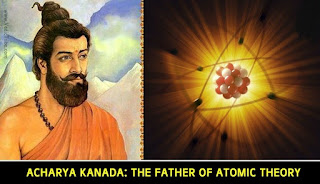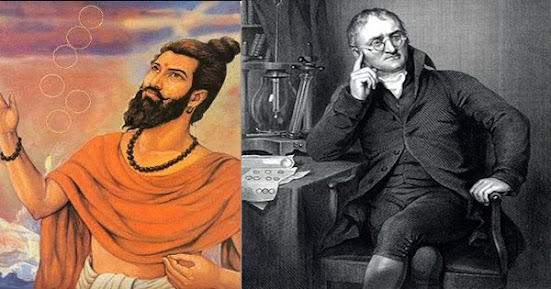THE INDIAN SAGE WHO DEVELOPED ATOMIC THEORY 2,600 YEARS AGO, NOT DALTON OF ENGLAND
Do you know Maharishi Kanad, an Ancient sage, scholar and scientist propounded a theories of atoms to clarify the creation and presence of the universe? Be that as it may, the disclosure of Aomic theory is ascribed to John Dalton, an English chemist, physicist, and meteorologist.
Our ancient Rishis first conceptualized the idea that matter consists of indivisible units and cannot be further divided into smallest particles. The smallest particle, i.e. atom pervades the whole universe. It can’t be destroyed and holds its unique frame under all circumstances. Our Rishis discovered this idea on an spiritual context. While Kanad was the first to give clear picture about this idea, scholars and thinkers from the later period created point by point speculations on how atoms consolidated to compounds.
Maharishi Kanad penned his clarifications on the atomic theory of issue in his book in Sanskrit called Vaisheshika Sutra, additionally named Kanada Sutras. This book is a Combination of science, logic and religion. He propounded the AtomicTheory in the lines of the idea of atman (soul) and moksha (liberation from the cycle of birth and Death). He connected logic and realism to clarify his theory. While Kanad lived During 600 BC (genuine date record isn’t available, yet he is accepted to have lived between 6th century to 2nd century BCE), Dalton belonged to the late 18th and 19th century.
Kanad was the Founder of Vaisheshika, one of the six noteworthy schools of Vedic Philosophy from Ancient India. The other five schools include Nyaya, Samkhya, Yoga, Mimamsa, and Vedanta. These schools believed in one of the accompanying criteria: 1) Vedas as a substantial wellspring of knowledge, 2) Brahman and Atman, and 3) Afterlife and Devas.
Kanad’s Vaisheshika School clarified about the creation and presence of the universe by proposing an atomistic Theory. The great sage connected rationale and realism to make inferences. Do you know Vaisheshika is considered one of the most punctual known deliberate pragmatist philosophy in mankind’s history? Philosophy, generally classified under mysticism, is the philosophical study of the nature and presence of creatures and elements, their groupings and chain of command, subdivisions, and related stuff.
Maharishi Kanad was additionally referred to by substitute names, for example, Kashyapa, Uluka, Kananda, and Kanabhuk. He has propounded six categories (padarthas), which are adequate to portray everything in the universe. These include:
1. Dravya (substance)
2. Guna (quality)
3. Karman (motion)
4. Samanya ( universal)
5. Visesa (particular)
6. Samavaya (inherence).
As per Maharishi Kanad’s Atomic Theory
1. Everything can be subdivided
2. After some time, subdivision prompts formation of parmanu (atom), which are the smallest elements
3. Parmanu(atom) is indissoluble; it can’t be additionally separated
4. In this manner, subdivision of everything can’t occur perpetually; it has an end
6. It is the reason for all material presence
7. Parmanu (atom)has extraordinary identity with a specific property. This property is same as the class of substance to which it belongs to
8. It is undetectable to the Naked eye
9. Through a procedure that includes warm or different elements particles could be joined in different approaches to create concoction changes
10. Parmanu (atom) can have two states – state of motion and absolute rest.
Greek philosophers Leucippus and Democritus later gave their clarifications on the idea of Atomic Theory. This was trailed by Dalton’s Theory. Yet, Maharishi Kanad’s Theory is significantly more progressed than those sent later by these scientists.
As per Dalton’s nuclear Theory,
1. All matter is made of extremely Small particles called molecules
2. Molecule is indivisible
3. It is indestructible
4. As far as mass and properties, all molecules of a given component are indistinguishable
5. Two or more different kinds of atoms form a compound
6. A chemical reaction is a rearrangement of atoms.
What Dalton has propounded in the 18th 19th century through compound experiments is like what Kanad proposed in 600 BC. While Maharishi Kanad’s clarifications are enmeshed in Philosophy, Dalton’s in Chemistry. Be that as it may, results are the same. So who found the idea of Atomic Theory ? Kanad or Dalton? It is upon the readers to decide based on the aforementioned facts.








0 Comments